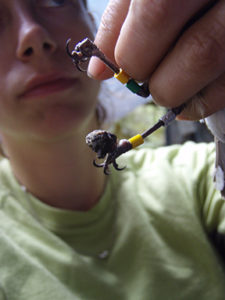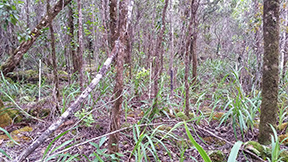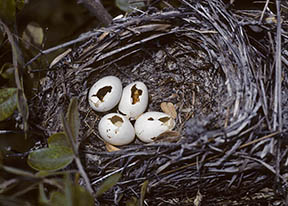Threats to Native Forest Birds
Before the arrival of humans in 400 A.D., many of Kaua’i’s forest bird species occupied forests island-wide, from mauka to makai. Since that time, humans have cleared and degraded forest bird habitats. Consequently, at least five native forest bird species have gone extinct and the remaining species have retreated to forests at higher elevations on Kaua’i.
Today, threats to native forest birds include:
HABITAT LOSS
After the Polynesians arrived, large expanses of lowland forest were burned (or cleared) for agriculture. This initial loss of forest was exacerbated after the arrival of westerners in 1778. Europeans cleared additional forests for cattle ranching and development and over-harvested valuable timber species such as koa (Acacia koa) and sandalwood (Santalum sp). In addition, both Polynesians and Europeans introduced alien species to Hawai’i, which forever altered the native habitats and species.
INVASIVE PLANTS
Introduced invasive plants species replace native species, changing forest structure and composition, which has wide-ranging repercussions for animal foraging and nesting habitat as well as hydrology. Non-native plants arrive in Hawai’i in a number of ways-sometimes purposeful and sometimes accidental. Kahili ginger (Hedychium gardenerianum) and miconia (Miconia calvescens) were introduced as ornamentals and are now dispersed by non-native birds and feral ungulates. These plants form monotypic (i.e., single species) stands and prevent the growth of native plants. Another very detrimental species is strawberry guava (Psidium cattleianum), which has converted large expanses of diverse native forest to monotypic stands. Strawberry guava was introduced for agricultural purposes. To prevent the further spread of alien plant species, visitors should carefully brush seeds from boots, clothing, and gear before venturing into Kaua’i’s forests. Also, pack out your garbage!
INVASIVE ANIMALS
Feral Ungulates
A number of feral (i.e., formerly domesticated animals that have returned to the wild) ungulate species inhabit Kaua’i and all disrupt native ecosystems. Because Hawai’i has no native herbivorous mammals, the native plants did not evolve appropriate defenses, such as spines or thorns. Feral goats eat plants without discrimination, preventing the growth and regeneration of native forest. Feral pigs are a major threat to native birds and their habitat. Pigs destroy understory plants and prevent forest regeneration by forming a matrix of muddy trails, pulling up tree seedlings, ferns and other plants to eat their roots. Pigs dig wallows that fill with water and provide breeding habitat for mosquitoes (Culex quinquefasciatus), which spread deadly non-native avian diseases such as avian malaria to native birds. Last, pigs eat the fruits of invasive species such as strawberry guava and purple plague (Clidemia hirta) and defecate their seeds, serving to disperse these species throughout the forest.
Introduced Predators
Three types of introduced predators affect native forest birds on Kaua’i. The most serious are introduced mammalian predators; because Hawai’i’s native forest birds did not evolve with mammalian predators, they have few natural defenses to these predators. Feral cats (Felis catus) are the most cryptic of these species. These stealthy hunters are known throughout the U.S. for preying on birds and Hawai’i’s native birds are no exception. Their presence is most often detected in native forests by the remains of prey and feces left behind on trails. Rats (Rattus norvegicus, R. exulans, and R. rattus) threaten native forest birds in two ways. One, they prey on nests, eating eggs, chicks, and incubating and brooding females. Second, they may compete with native birds for food resources, such as fruit and invertebrates that make up a large portion of the rat diet. Lastly, the introduced Barn Owl (Tyto alba) also likely threatens our native forest birds to some degree, by preying on adults and nestlings. To learn more about introduced mammalian predators in Hawai’i, this newsletter from the Conservation Council for Hawai’i is a great resource.
Non-native Birds
Non-native birds (and some native birds) serve as disease reservoirs as they are able to carry avian malaria and pox. More than 170 species of birds have been introduced to the Hawaiian Archipelago since the arrival of humans, and fifty-four of those have established wild populations today. These birds have evolved resistance to the parasitic and viral pathogens that they brought with them when introduced to Hawai’i, and can act as carriers. Some species, such as the Japanese White-eye (Zosterope japonicus japonicas), Northern Cardinal (Cardinalis cardinalis), Japanese Bush Warbler (Cettia diphone), Melodious Laughing Thrush (Garrulax canorus), and White-rumped Shama (Copsychus malabaricus), have managed to establish populations in the high-elevation forests where they may compete with native birds for food and nesting habitat.
DISEASE
Introduced house mosquitoes (Culex quinquefasciatus) and the diseases they carry have caused a number of extinctions, and continue to contribute to population declines and range contractions of native forest birds. Having evolved in the absence of many avian diseases, many native forest bird species are highly susceptible to them. The two major disease threats are avian malaria and avian poxvirus (Avipoxvirus). Avian malaria is the avian equivalent to human sleeping sickness. It results when a blood-borne parasite, Plasmodium relictum, is transmitted from infected birds to healthy birds by mosquitoes under suitably (warm) temperatures. Once infected, many birds die. Thus, the introduction of mosquitoes made it possible for native birds to become infected, given that a reservoir of disease was present.

Avian poxvirus is a virus which also can be transmitted by mosquitoes, although transmission can occur via bird-bird contact or contact with infected perches. Once infected, native and non-native birds alike grow lesions on exposed areas of the body, such as the beak and legs. These lesions often cause the loss of toes and beak deformities, and eventually death.
CLIMATE CHANGE
Due to the existence of diseases like avian malaria and avian poxvirus, native forest birds are now restricted to high-elevation forests where cooler weather precludes mosquito breeding and parasite development. Unfortunately, even Kaua’i’s highest peaks are too low to prevent transmission during the warm summers. Under most climate change scenarios, even the forests on the highest mountains will soon experience year-round temperatures warm enough to promote disease transmission, which will have devastating consequences for most native bird species.
HURRICANES AND FIRES
Major hurricanes struck Kaua’i in 1983 and 1992, destroying and degrading native forest bird habitat, by creating gaps into which alien plants could expand, spreading invasive plants, and felling large canopy trees that are the favored nest sites of some species, such as ‘Akikiki. For example, large numbers of dead trees killed by hurricane Iniki in 1992 can still be seen in several areas where ‘Akikiki have declined in abundance or disappeared. Some forest birds (for example, Kama’o) have not been seen since Iniki. Single island endemics, like many of Kaua’i’s native birds, are inherently more vulnerable to extinction than widespread species because of the higher risks posed to a single population by random fluctuations in population size, and localized catastrophes such as hurricanes or fires.


